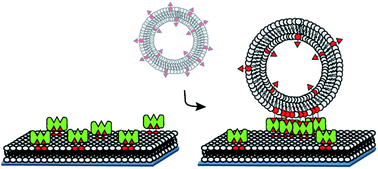当前位置:
X-MOL 学术
›
Chem. Sci.
›
论文详情
Our official English website, www.x-mol.net, welcomes your feedback! (Note: you will need to create a separate account there.)
Recruitment of receptors at supported lipid bilayers promoted by the multivalent binding of ligand-modified unilamellar vesicles
Chemical Science ( IF 8.4 ) Pub Date : 2020/03/09 , DOI: 10.1039/d0sc00518e Daniele Di Iorio 1, 2, 3, 4, 5 , Yao Lu 1, 2, 3, 4, 5 , Joris Meulman 1, 2, 3, 4, 5 , Jurriaan Huskens 1, 2, 3, 4, 5
Chemical Science ( IF 8.4 ) Pub Date : 2020/03/09 , DOI: 10.1039/d0sc00518e Daniele Di Iorio 1, 2, 3, 4, 5 , Yao Lu 1, 2, 3, 4, 5 , Joris Meulman 1, 2, 3, 4, 5 , Jurriaan Huskens 1, 2, 3, 4, 5
Affiliation

|
The development of model systems that mimic biological interactions and allow the control of both receptor and ligand densities, is essential for a better understanding of biomolecular processes, such as the recruitment of receptors at interfaces, at the molecular level. Here we report a model system based on supported lipid bilayers (SLBs) for the investigation of the clustering of receptors at their interface. Biotinylated SLBs, used as cell membrane mimics, were functionalized with streptavidin (SAv), used here as receptor. Subsequently, biotinylated small (SUVs) and giant (GUVs) unilamellar vesicles were bound to the SAv-functionalized SLBs by multivalent interactions and found to induce the recruitment of both SAv on the SLB surface and the biotin moieties in the vesicles. The recruitment of receptors was investigated with quartz crystal microbalance with dissipation monitoring (QCM-D), which allowed the identification of the biotin and SAv densities necessary to obtain receptor recruitment. At approx. 0.6% of biotin in the vesicles, a transition between dense and low vesicle packing was observed, which coincided with the transitions between recruitment in the vesicles vs. recruitment in the SLB and between full and partial use of the biotin moieties in the vesicle. Direct optical visualization of the clustering at the interface of individual GUVs with the SLB platform was achieved with fluorescence microscopy, showing recruitment of SAv at the contact area as well as the deformation of the vesicles upon binding. Different vesicle binding regimes were observed for lower and higher biotin densities in the vesicles and at the SLBs. A more quantitative analysis of the molecular parameters implied in the interaction, indicated that approx. 10% of the vesicle area constitutes the contact area. Moreover, the SUV binding and recruitment appeared to be fast on the analysis time scale, whereas the binding of GUVs is slower due to the larger SLB area over which SAv recruitment needs to occur. The mechanisms revealed in this study may provide insight in biological processes in which recruitment occurs.
中文翻译:

通过配体修饰的单层囊泡的多价结合促进在支持的脂质双层上的受体募集
为了更好地了解生物分子过程,例如在分子水平上的界面受体募集,模拟生物学相互作用并允许控制受体和配体密度的模型系统的开发至关重要。在这里,我们报告基于支持的脂质双层(SLBs)的模型系统,用于研究受体界面处的簇集。用链霉亲和素(SAv)功能化用作细胞膜模拟物的生物素化SLB,在此用作受体。随后,生物素化的小(SUV)和巨型(GUV)单层囊泡通过多价相互作用与SAv功能化的SLB结合,并发现既诱导SAv在SLB表面募集,又诱导囊泡中的生物素部分募集。用耗散监测(QCM-D)石英晶体微天平研究了受体的募集,这可以鉴定获得受体募集所需的生物素和SAv密度。大约 囊泡中生物素含量为0.6%,观察到了密集和低囊泡堆积之间的过渡,这与囊泡募集之间的过渡相吻合与在SLB中募集以及在囊泡中生物素部分的完全使用和部分使用之间。用荧光显微镜对单个GUV与SLB平台的界面处的簇进行了直接光学可视化,显示了SAv在接触区域的募集以及结合后囊泡的变形。观察到在囊泡和SLB中较低和较高的生物素密度的不同囊泡结合方案。相互作用中暗示的分子参数的更定量分析表明,大约。囊泡面积的10%构成接触面积。此外,在分析时间尺度上,SUV的结合和募集似乎很快,而由于需要SAv募集的较大SLB区域,因此GUV的结合较慢。
更新日期:2020-03-26
中文翻译:

通过配体修饰的单层囊泡的多价结合促进在支持的脂质双层上的受体募集
为了更好地了解生物分子过程,例如在分子水平上的界面受体募集,模拟生物学相互作用并允许控制受体和配体密度的模型系统的开发至关重要。在这里,我们报告基于支持的脂质双层(SLBs)的模型系统,用于研究受体界面处的簇集。用链霉亲和素(SAv)功能化用作细胞膜模拟物的生物素化SLB,在此用作受体。随后,生物素化的小(SUV)和巨型(GUV)单层囊泡通过多价相互作用与SAv功能化的SLB结合,并发现既诱导SAv在SLB表面募集,又诱导囊泡中的生物素部分募集。用耗散监测(QCM-D)石英晶体微天平研究了受体的募集,这可以鉴定获得受体募集所需的生物素和SAv密度。大约 囊泡中生物素含量为0.6%,观察到了密集和低囊泡堆积之间的过渡,这与囊泡募集之间的过渡相吻合与在SLB中募集以及在囊泡中生物素部分的完全使用和部分使用之间。用荧光显微镜对单个GUV与SLB平台的界面处的簇进行了直接光学可视化,显示了SAv在接触区域的募集以及结合后囊泡的变形。观察到在囊泡和SLB中较低和较高的生物素密度的不同囊泡结合方案。相互作用中暗示的分子参数的更定量分析表明,大约。囊泡面积的10%构成接触面积。此外,在分析时间尺度上,SUV的结合和募集似乎很快,而由于需要SAv募集的较大SLB区域,因此GUV的结合较慢。



























 京公网安备 11010802027423号
京公网安备 11010802027423号